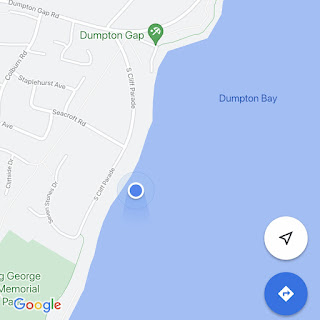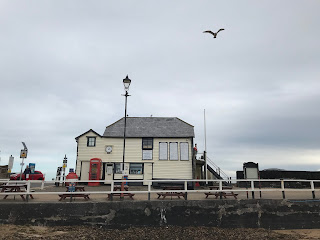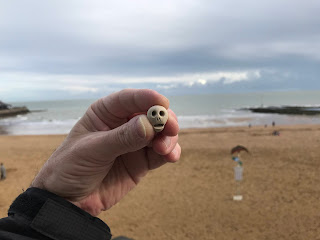On
a day so hot that it felt as if stone may melt, rather than staying somewhere
cool and with a bit of shade, I went for a wander along the clifftop walk
between Broadstairs and Margate. On the
road approaching the Captain Digby pub, I saw the old, familiar landmark in the
distance of what looks like a fort, sitting almost on the cliff edge at
Kingsgate. I took a slug of lukewarm
water from my water bottle, poured some over my head to cool down my sweaty
body and marched on.
On
reaching the fort, I had a quick look round to make sure no one was looking and
clambered quickly through one of the windows.
Unfortunately, the fort, or should I say folly, sits on the edge of a
golf course and is therefore on private land.
I had a quick peak around to check there was no one stupid enough to be
golfing in this heat, there wasn’t, and so it was time for a look around.
The
folly, or Arx Ruochim, to give it its official title was built under the
instruction of the rather eccentric nobleman, Henry Fox, Lord Holland, in
around 1760. It was built to be similar
in appearance to the castles built along the Kentish coast by Henry VIII, as in
it had four bastions and a tower in the central courtyard.
Arx Ruochim supposedly sits on the site of an ancient tower built in the time of King Vortigern (King of the Britons), in around AD 448. According to the ‘Picturesque Companion to the Isle of Thanet, Dover, Canterbury, and Parts Adjacent’, the name Arx Ruochim derives from Innis Ruochim, meaning Roman’s Isle, in the ‘old British language.’ How true any of this is, I really have no idea.
The
tower in the courtyard of the folly could be used as a look out post, and it
was used for this purpose as late as the 1940s, when members of the Royal
Observer Corps were based there during the Second World War. In the 1970s the tower was demolished.
Various
uses have been put forward for Arx Ruochim.
In 1936, permission was sought from the council by Charles Richards to
turn it into a house. I assume this idea
must have been rejected, given that it is not now a house. In 1975, the Thanet Amateur Astronomers proposed
to convert the building into an observatory and their headquarters, as it is in
an isolated spot away from street lighting.
Again, this never happened, and it was left to be what it had always
been, an oddity sitting on the cliffs at Kingsgate.
Wandering
around inside the folly, I found there wasn’t much there now, other than dog
poo and a couple of discarded plastic bottles that had once contained some cheap
cider. There was a circle of stone in
the centre where the tower had once stood and the walls inside were of the same
sharp flint as the walls on the outside.
I
left a Skulferatu in a nicely curved gap of cement and flint. Then, spying some fat, red faced golfers puffing
there way along the course in the insane afternoon heat, I clambered back out
of the window and left.
The
coordinates for the location of the Skulferatu are –
Latitude
51.387088
Longitude
1.441109
what3words:
motel.overnight.snow
I
used the following sources for information on Arx Ruochim –
The
Queen - Saturday 14 January 1893
Thanet
Advertiser - Friday 09 October 1936
East
Kent Times and Mail - Wednesday 23 April 1975









































